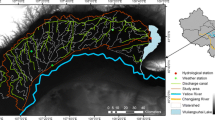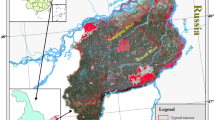Abstract
The Sanjiang Plain is the largest and most concentrated wetland region in China, the total area is about 1.088 × 107ha with rich marsh resources and biodiversity. Before 1949, the Sanjiang Plain was a large untravelled wild plant and waterfowl habitat, and there were some rare swans, red-crowned cranes and thousands of hydrophytes. From 1950, the local government began to reclaim the marsh in the Sanjiang Plain, built the commodity grain base of Northeast China, and developed the industry of grain processing, animal husbandry, etc. Up to now, there are 54 farms which control 3. 5087 × 106ha agriculture field. The marsh areas are reduced by 1/2; many rare animals and plants are near extinction. The human activities and agriculture reclamation made a great change on the environment, especially made water balance change and regional climate change. So to study and protect the wetland ecosystem and marsh resource are extremely urgent. This paper focus on the hydrology change and climate change before and after marsh reclamation, including evapotranspiration, run off, soil character, micro-climate on both marsh and agriculture field, and the reason that cause seasonal drought, waterlogging and degeneration of marsh.
Similar content being viewed by others
References
CHEN Gang-qi, WANG Yi-yong et al., 1993. A study on marsh evapotranspiration in the Sanjiang Plain[J]. Scientia Geographica Sinica, 13(3): 220–226. (in Chinese)
CHEN Gang-qi, MA Xue-hui, 1997. Research on changes of ground feature and water balance of marsh before and after marsh reclamation in Sanjiang Plain[J]. Scientia Geographica Sinica, 17(supp.): 427–433. (in Chinese)
Department of Swamp Research, Changchun Institute of Geography, 1983. The Swamp of Sanjiang Plain [M]. Beijing: Science Press. (in Chinese)
LIU Yin-liang, LU Xian-guo and Yang Qing, 1994. Influence of the wetland reclamation on the soil ecosystem in northeast China[A]. In: Wetland Environment and Peatland Utilization[C]. Changchun: Jilin People’s Publishing House, 194–199.
SHEN Mao-cheng, 1998. An urgent attention to conservation of Sanjiang Plain wetland[J]. Wetlands International, (5): 2–5.
WANG Yi-young, LIU Zhao-li, 1994. Effects of regional climate after marsh land reclamation in the Sanjiang Plain[A]. In: Wetland Environment and Peatland Utilization[C]. Changchun: Jilin People’s Publishing House, 211–217.
YANG Yong-xing, Liu Xing-tu et al., 1996. The problems of ecological environment and exploitation of marsh cological agriculture [A]. In: Study on Marsh in the Sanjiang Plain [C]. Beijing: Science Press, 146–151. (in Chinese)
Author information
Authors and Affiliations
Additional information
Foundation item: Supported by the National Natural Science Foundation of China (No. 49771002) and the Foundation of the Laboratory of Wetland Process and Environment, Changchun Institute of Geography, the Chinese Academy of Sciences and Key Ninth Five-Year Plan Project of the Chinese Academy of Sciences(No. KZ951-B1-201-03).
Biography: Wang Yi-yong (1966 —), male, a native of Gansu Province, associate professor. His research interest includes climate environment of wetland and agriculture meteorology.
Rights and permissions
About this article
Cite this article
Wang, Yy., Yang, Yx. Effects of agriculture reclamation on the hydrologic characteristics in the Sanjiang Plain, China. Chin. Geograph.Sc. 11, 163–167 (2001). https://doi.org/10.1007/s11769-001-0037-x
Received:
Issue Date:
DOI: https://doi.org/10.1007/s11769-001-0037-x




